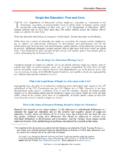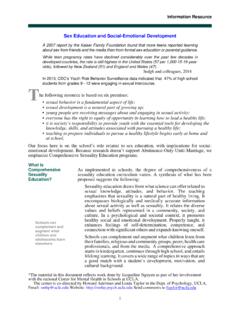Transcription of Teaching Sex Education in Thailand - ERIC
1 0 Journal of Researchby Noy S. Kay, Megan R. Jones, Sudgasame Jantaraweragul, Indiana UniversityAbstractThe purposes of this study were to examine the current situation pertaining to the Teaching of sex Education and identify barriers to Teaching sex Education among Thai health Education teachers. A survey questionnaire was administered to 193 health Education teachers who participated in this study. The questionnaire was comprised of three parts: (1) demographic questions, (2) the current status of sex Education in Thailand , and (3) the barriers to Teaching sex Education . The third part was comprised of teacher characteristics, curriculum and multimedia, and environmental factors. The findings focused on the main effect interaction analysis between a dependent variable (gender, age, level of Education , etc.) and the three factorial scales generated by using the Factor Analysis Procedure from the questionnaire.
2 There were no significant differences found between the dependent variables and the three factors associated with Teaching based on Analysis of Variance (ANOVA) at p= Using descriptive statistics, we found teachers held interesting perspectives on factors surrounding sex Education . So, although there were no significant differences in the findings, the study indicates that health Education teachers contribute to the quality of Teaching and the learning process of sex Education . They play a critical role in designing and implementing sex Education courses. Key words: students, health, teachers, curriculum Educating children, pre-teens, and teenagers about sex is important and assists in developing social skills. Students can use these skills to avoid unwanted pregnancies, sexually transmitted infections (STIs) and HIV/AIDS that could otherwise hinder a fulfilling life. In Thailand , sex Education includes classes or presentations that discuss human reproduction, dating relationships, abstinence, STIs, HIV/AIDS, pregnancy prevention, contraception, family planning, and related sexual activities.
3 Providing proper age-appropriate information is initiated from predetermined traditional settings, authority opinions, workshops, seminars, studying past research related to the topic, and exploring the current sex Education curriculum being implemented in schools. New knowledge and extended research are needed to improve understanding and further develop sex Education in Thailand . Thai male and female adolescents lack the experience of formal educational information, which leads to unsafe sex activities. Sex Education could assist in extinguishing misconceived stereotypes (Vuttanont, Greenhalgh, Griffin, & Boynton, 2006). Their study described how society and the stereotypes society had contributed led to unhealthy life styles that influenced adolescents to engage in protection free sexual activities. Thai male adolescents are encouraged to tell stories of sexual conquest as a way of boosting their status in society (Vuttanont et al.)
4 , 2006). There is a widespread acceptance that men have a right to engage in premarital or extramarital sexual affairs (Cash, Anansuchatkul , & Busayawong, 1999). Thai females are encouraged to keep their traditional submissiveness, which leads to insufficient negotiating skills (Vuttanont et al., 2006). For example, females often leave the decision of condom use to males because it is men s business (Cash et al., 1999). In addition, condom use has a negative connotation in adolescents because of the connection between condoms being used in the commercial sex industry (Jenkins et al., 2002). The aforementioned gender-related stereotypes lead to unprotected sexual encounters through coercion (Vuttanont et al., 2006). In addition to the stereotypes reinforcing unprotected sex, the sex Education taught within the schools narrowly focused on biological content and was inconsistently delivered throughout the school system (Vuttanont et al.
5 , 2006). Students lacked applicable knowledge about desirable sex and therefore did not have the adequate skills to participate in sexual encounters safely. Having a sex Education program that takes into consideration the needs of adolescents to receive knowledge about peer norms, gender stereotypes, and life skills could help prevent undesirable sexual interaction (Jenkins et al., 2002; Mahattano, Warakamin & Pongkittilar, 2004; Vuttanont et al., 2006). A reoccurring theme found in the research for sex Education in Thailand is that sex Education programs fail to focus on proper knowledge to help adolescents make healthy decisions related to sexual preference. Lyttleton (1994; 1996) has explored this issue and found that Education programs being controlled by central authorities are run from a top-down perspective. This has led to information that lacks the details that are relevantly vital to individuals learning about sex Education .
6 Having a one size fits all approach has not been effective for sex Education (Lyttleton, 1994; Lyttleton, 1996). Focusing more on a curriculum that takes the students needs into consideration and focuses on age-appropriate information may serve to be more effective in the long run. How teachers respond to the guidelines given to them will provide more information on how sex Education was introduced in schools and how it may need to be altered to help meet the needs of its audience. Past research has shown that peer programs that are based on reproductive health have provided knowledge and increased positive attitudes about the subject within the student population (Mahattano et al., 2004.). They suggested that in order for sex Education to be effective there needs to include input from students helping develop guidelines, strategies, and curricula that will be relevant to their needs. Sex Education had not been formally incorporated into Thailand s Compulsory Education Curriculum until 2001 (Noppakunthong, 2007).
7 Lack of sex Education in the home and the inability to talk about sexuality in public because of its taboo nature had pushed the responsibility of Teaching sex Education onto the teachers. In Teaching Sex Education in Thailandvolume 5, issue 2 Teaching Sex Educationaddition, the years in school without proper sex Education have led to an increase in sexually transmitted infections and unwanted pregnancies (Grunseit, 1997). In one study, teachers were more aware of sex Education topics such as emergency contraceptive pills (ECPs) than guardians were (Sripichyakan & Tangmunkongvorakul, 2006). Teachers also had more positive attitudes towards topics such as ECPs and the moral issues surrounding contraception (Sripichyakan & Tangmunkongvorakul, 2006). Both teachers and guardians need additional instruction on sex Education content to increase accurate knowledge that will be passed onto adolescents.
8 Teachers and guardians also agreed that adolescents should learn about ECPs and other sex Education topics (Sripichyakan & Tangmunkongvorakul, 2006). Therefore, a decade ago, Thailand turned to its formal channel, the school system, to educate school-aged children on sexual behavior (Ministry of Education , 2001). Schools have access to a wide variety of individuals, which allows sex Education to have a widespread captive audience (Smith, Kippax, & Aggleton, 2000). Thus, sex Education was implemented into elementary and secondary schools in order to reach different age groups and be able to provide age-appropriate material (Ministry of Education , 2001). The sex Education curriculum was formed with the cooperation among government agencies, private entities, educators, and health providers. Universities, Ministry of Education , and Ministry of Public Health first introduced a guideline curriculum to integrate sex Education from the first grade through the twelfth grade.
9 Strategies for teacher preparation developed as well as integrating sex Education into various subject matters (Peerapipat, 2006). Similarly, HIV related Education was incorporated into many curriculum subjects, which has allowed for the incorporation of social development and acquisition of life skills along with HIV Education (Phoolcharoen, 1998; Smith, Kippax, Aggleton, & Tyrer, 2003). The very first hurdle schools experienced when incorporating a sex Education program was the lack of budget funding for personnel, materials, equipment, teacher in-services, and so on (Peerapipat, 2006). In addition, majors in sex Education were not offered as part of a Teaching degree in any university. Assigning teachers to have the primary duty of Teaching sex Education became a new challenge for the whole process of Teaching sex Education through the school (Peerapipat, 2006). Challenges such as these and many others inspired this study to focus on examining the status of, and the barriers to, Teaching sex Education .
10 This study lends itself to investigating from teachers opinions and attitudes what they have experienced after nearly a decade of sex Education curriculum implementation. This study explored teachers experiences on curriculum implementation, classroom activities, instructional content, Teaching strategies, and field support from the school and community. It is a study that identified characteristics of teachers and examined the barriers or problems confronting teachers in classrooms and activities surrounding the Teaching environment. Method Participants This study illustrates a general perception of teachers who are Teaching sex Education in middle schools and high schools in Thailand . A questionnaire was given to teachers, as study subjects, who were currently Teaching sex Education in middle and high school. Included in this study, 193 teachers were randomly selected to be the subjects representing teachers currently Teaching sex Education .



















